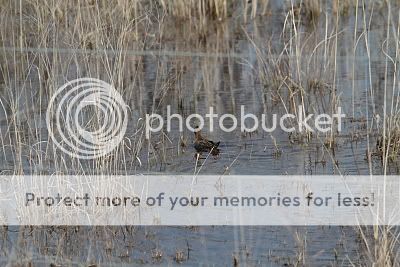Hi folks
Yesterday Jenny and I had the pleasure of finally getting to see this tiny bird. Niall Perrins joined us for the day, as he was still missing the crake in his quest for 800 in one year. We travelled to the Soutpan area,
north of Bloemfontein, to an area of flooded grassland. The exact coordinates were kindly posted on SABirdnet by Dawie Kleynhans, and further advice was given by Allan Ridley. Many thanks to them both.
After driving up and down the flooded area a few times (using the car as a hide) we picked up some movement below the barbed wire fence in a more thickly grassed area. Niall called out "There it is, there, there". Jenny caught a better glimpse than I managed. The bird then proceeded to skulk in its patch of thick grass! After half-an-hour of lurking balefully we gave up and pushed off to do some general birding. The area is full of shallow pans at the moment and numerous ducks, geese and waterfowl were on show.
An hour later we returned, mindful of our target - a skulker of note. We stopped at the clump of grass where it had previously skulked, to no avail. Moving slowly south, Jenny picked up some movement, once again just below the fence, and .... there it was! The sequence of photos below was taken over a period of about 90 seconds.
Skulking behind the first clump of grass

Out in the open, no submerged grass to sprint across

A half-decent photo in open water

before turning away from us

Cover within reach......

Phew, nearly there!

After skulking in the second patch of grass for a short while, the bird burst into view,
flying low in typical crake fashion to land in very thick cover some distance away.
That, as they say, was that. Quite a show!
Whilst nursing some much needed coffee, our satisfied trio were given a fly-past by an
African Marsh Harrier, and then departed back to Gauteng with "another one in the bag".
Happy birding!
Yesterday Jenny and I had the pleasure of finally getting to see this tiny bird. Niall Perrins joined us for the day, as he was still missing the crake in his quest for 800 in one year. We travelled to the Soutpan area,
north of Bloemfontein, to an area of flooded grassland. The exact coordinates were kindly posted on SABirdnet by Dawie Kleynhans, and further advice was given by Allan Ridley. Many thanks to them both.
After driving up and down the flooded area a few times (using the car as a hide) we picked up some movement below the barbed wire fence in a more thickly grassed area. Niall called out "There it is, there, there". Jenny caught a better glimpse than I managed. The bird then proceeded to skulk in its patch of thick grass! After half-an-hour of lurking balefully we gave up and pushed off to do some general birding. The area is full of shallow pans at the moment and numerous ducks, geese and waterfowl were on show.
An hour later we returned, mindful of our target - a skulker of note. We stopped at the clump of grass where it had previously skulked, to no avail. Moving slowly south, Jenny picked up some movement, once again just below the fence, and .... there it was! The sequence of photos below was taken over a period of about 90 seconds.
Skulking behind the first clump of grass

Out in the open, no submerged grass to sprint across

A half-decent photo in open water

before turning away from us

Cover within reach......

Phew, nearly there!

After skulking in the second patch of grass for a short while, the bird burst into view,
flying low in typical crake fashion to land in very thick cover some distance away.
That, as they say, was that. Quite a show!
Whilst nursing some much needed coffee, our satisfied trio were given a fly-past by an
African Marsh Harrier, and then departed back to Gauteng with "another one in the bag".
Happy birding!



















